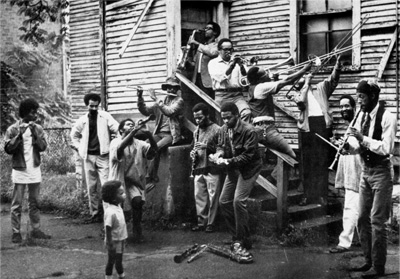The DuSable Museum was a flurry of activity on MLK Day. Grammy Award-winning artist J. Ivy performed in the auditorium, family-friendly films on the civil rights movement played on repeat, docents led tours, and in one of the main galleries upstairs, a small exhibition focusing on a group of musicians from the South Side opened its doors.
“Free at First: The Audacious Journey of the Association for the Advancement of Creative Musicians” takes up a different kind of struggle than the one most of the crowd focused on last week. The AACM constantly sought creative expression through music—jazz, to be specific. A sound that comes up through the heels of feet and bent knees, arches through the back, and explodes out of brass, wood, and steel. Fast, improvisational, momentary.
The initial premise of “Free at First” is spelled out in the title. Namely, that the group of musicians, and—importantly—the music itself, was “free” to begin with: free from creative stifling, free from institutions, and free from the traditional money-run world of entertainment.
“The only jobs that we’re going to have where we can really perform original music are concerts we promote,” proclaimed Jodie Christian, one of AACM’s founders. His words are written neatly on one wall over a photograph of him at the piano. Next to him are photos of the other founders: Kelan Phil Cochran, Steve McCall, and Muhal Richard Abrams. Above Abrams’s head appears the dictum, “We need to be remembered as representing ourselves.”
Formed in 1965, two years after King’s “I Have a Dream” speech, three years before his assassination, and in the same year as the Selma-Montgomery march, the AACM has evident ties to both King and the civil rights movement. Yet, instead of having to fight for their rights, the AACM asserted them from the very beginning. They weren’t asking to be allowed in, but rather pushing to open the door, showing what was possible—and, after them, expected—in experimental jazz. Free at first.
The DuSable’s exhibit uses anything it can find to create a portrait of this amorphous, dynamic group, the whole thing a feeling of collage. Though there is perhaps no other way to capture a group that, in their fiftieth year, calls themselves the “oldest and most venerable organization of its kind.” A rather modest title, given the DuSable’s assertion that the AACM is the only remaining musician’s collective, a fact nearly impossible to prove.
Nonetheless, inside the DuSable exhibit’s MLK Day opening, these concerns were put aside as a mix of parents, children, retirees, and the occasional young adult wandered through the collection of photos, posters, clothing, objects, and TVs.
In addition to the paraphernalia lining the walls and filling a few museum cases, in one corner stood a large musical contraption titled “StepHopThread Airborne” created by AACM member Douglas Ewart. The instrument, placed in the largest room of the exhibit, consists of a metal frame with three horizontal bars running through it. On these bars hang hubcaps, in addition to large metal plates, cowbells, a wooden slit drum with a mallet, and other sundry metal objects that may or may not have come from an actual car.
Children and adults alike flocked to the massive instrument, testing out the sound of an old Mercedes hubcap versus a newer Chevrolet, brake disc versus cowbell. The ruckus mixed with videos of live performances, creating a soundtrack oddly fitting for the experimental musicians the exhibition attempts to capture.
Wandering through the rooms of “Free at First” is a bit like going on a treasure hunt. Photos cluster together on walls painted pumpkin yellow and bright red. Looking closely, wonderful details pop out: a man playing a saxophone that must be at least six feet tall, a concert poster from Japan near an album recorded live in 1972 at Mandel Hall, just a few blocks east of the museum.
On one of the TV screens, an excerpt from a documentary on saxophonist Kalaparusha Maurice McIntyre, Closeness, plays. In one segment, McIntyre tells a story about playing with Miles Davis, who told him to stuff cotton in his ears to keep the band from blowing his eardrums. On stage McIntyre found a groove, and kept riffing on it, eyes closed until he cracked a lid to find he was the only one left on the stage. Davis and his band had left, frustrated by the sax player from Chicago who wouldn’t shut up. McIntyre tells the tale with a grin.
McIntyre passed away in 2013, and most of the other early members of the AACM (not to mention the Prince of Darkness himself, Miles Davis) have passed away as well. With the AACM heading into its fiftieth year, heaps of great music and scores of nearly mythic musicians in its wake, “Free at First” could easily have been all nostalgia. The AACM was “free” from the beginning. And despite the slow decline of popular interest in jazz, and the equally slow but just as acidic disappearance of music venues across the South Side, maybe it still can be. After the DuSable’s entrance fee, of course.
DuSable Museum of African American History, 740 E. 56th Pl. Through September 6. $10; free Sundays. (877)387-2251. dusablemuseum.org
Correction February 27, 2015: An earlier version of this article misidentified Douglas Ewart’s “StepHopThread Airborne” as a recreation of Henry Threadgill’s instrument the “Hubkaphone.”



